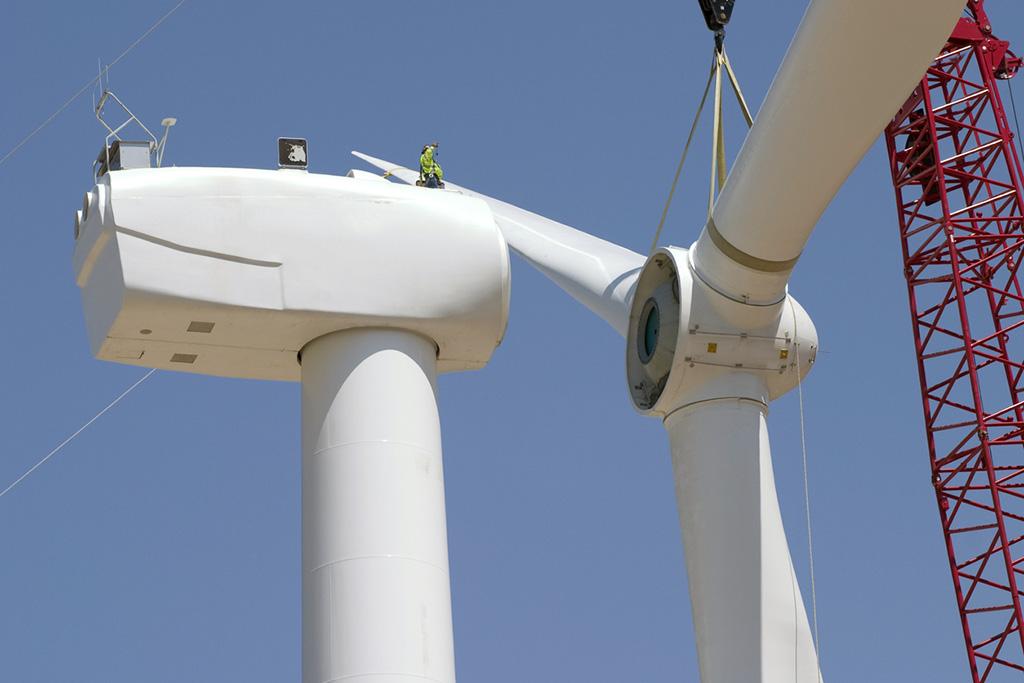
Wind Turbine Rotor Assembly
Project Highlights
- Address bolting issues and identify mitigation strategies for successful implementation at the wind farms
- Assemble blade stud installation and maintenance processes, material characterization, fleet wide failure data and root cause analysis of specific failures
- Evaluate existing and alternative installation and maintenance techniques through laboratory testing
- Perform field measurements of in-situ operational loads to calibrate service life expectations
Background, Objectives, and New Learnings
Over the last two decades, wind turbine models have grown rapidly both in power rating and size. Wind turbine operators have observed a large number of premature, unexpected failures in the structural bolted joints of wind turbines. Some of the most affected joints include the blade-pitch bearing interfaces and failures of the bolts (blade studs). This issue is a concern for turbine safety, reliability, and operational costs.
There is a gap in knowledge in not only what is causing these unexpected bolt failures, but also in how to improve bolt longevity and mitigate bolt failures. Possibilities contributing to failures include bolt design, specifications, material defects, installation practices, and maintenance practices.
To work towards closing this gap, EPRI is launching this project: Integrated Life Management of Wind Turbine Bolts. Objectives of this project include:
- Characterize and document typical failure modes for wind turbine blade root studs.
- Understand the key factors influencing failures of wind turbine blade root studs.
- Characterize blade root stud preload behavior and operational loading during installation, relaxation, maintenance, and operation.
- Identify possible areas of improvement in blade root stud fatigue life through quality, sourcing, and/or installation and maintenance practices to improve bolt reliability and longevity.
- Identify opportunities for advanced operations and maintenance options for improving bolt reliability and performance such as condition monitoring, predictive maintenance, and alternative non-destructive evaluation methods.
Benefits
The results of this study will provide the fundamental understanding of the factors impacting wind turbine bolt service life and generate best practices to improve bolted joint serviceability, reliability, and longevity. EPRI is to conduct material characterization and root cause analysis (RCA), study operational loading, and evaluate installation and maintenance techniques. Efforts to better understand the drivers of and mitigate generation asset component failures can ultimately benefit the public through improved electricity reliability and affordability.
Project Approach and Summary
The Integrated Life Management of Wind Turbine Bolts project will utilize a combination of laboratory and field-testing results, combined with fleet wide data collected from project funders, to enhance the understanding of and provide best practices for achieving desired performance from the blade studs. The anticipated activities include:
- Installation and maintenance procedures review, ex-service stud failure characterization and industry failure analysis data collection.
- Blade stud material characterization including ultimate tensile strength and fatigue testing to evaluate potential methods to increase stud performance.
- Experimentation on contributing factors to service life degradation to include laboratory pretension and relaxation testing, including intentional misalignment, field testing to characterize in-situ operational blade stud loads, and laboratory fatigue testing extrapolate potential life improvements.
- Evaluation and demonstration of potential methods of utilizing integrated life management approaches for increasing blade stud reliability.
Deliverables
The deliverables from the project include:
- Technical summary of fleet level blade stud failure data, common failure modes, maintenance practices, and materials characterization from select failed specimens.
- Documentation on the analysis of laboratory testing and field experiments to support characterization of bolt performance.
- Technical report outlining bolt performance characterization and the potential methods for improvement of service life in the field.
- Technology transfer webcasts and consultation for application of the research deliverables.
Price of Project
The total cost for participation in the project is $96,000. The project requires a minimum of four funding members to begin work, including one member volunteering to host the field measurement campaign. If more than six funding members join the project, the project scope may be expanded to include more in-depth analysis of the bearing and hub loading or to a second wind turbine platform to diversify learnings. This project qualifies for Self-Directed funding.
Project Status and Schedule
Initial material characterization of failed blade studs and collection of operator failure data has provided the foundation for this project to explore potential methods of improving blade stud performance. The project will span three years with an anticipated period of performance of 30 months.
Who Should Join
Initial material characterization of failed blade studs and collection of operator failure data has provided the foundation for this project to explore potential methods of improving blade stud performance. The project will span three years with an anticipated period of performance of 30 months.
Contact Information
For more information, contact the EPRI Customer Assistance Center at 800.313.3774 (askepri@epri.com).
Technical Contacts
Curtiss Fox at 704.595.2391 (cfox@epri.com)
Lili Haus at 704.595.2277 (lhaus@epri.com)
Brandon Fitchett at 704.595.2047 (bfitchett@epri.com)